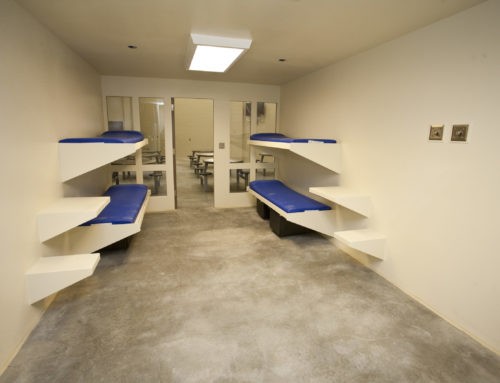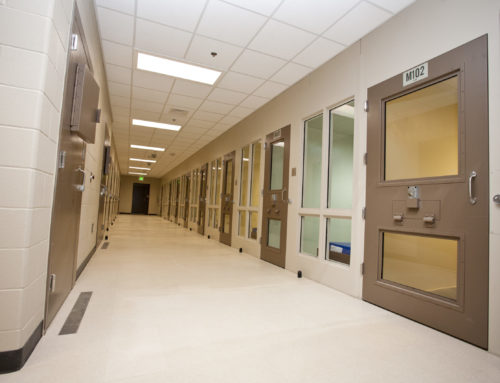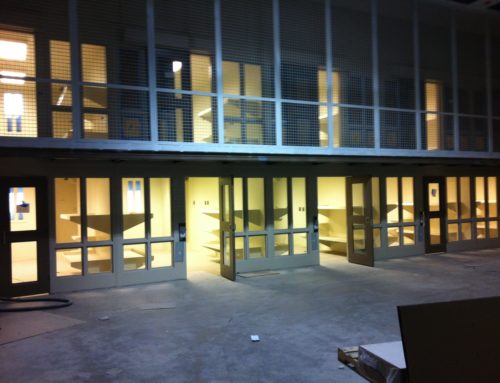In an era of shrinking budgets and outdated jail facilities, insufficient programming space and personnel resources, jail managers are faced with growing challenges in providing adequate inmate programming and educational services.
Today, society expects the jails to provide programs to reduce recidivism, such as life skill, substance abuse counseling and workforce training. The Sheriff’s Office and Jail in Kalamazoo, Michigan is no different. Built in 1972 with an original rated capacity of 248 inmates, the linear style jail has grown into an overcrowded home for nearly 400 inmates, stressing budgets, staff, and severely limiting programming options. Alternative methodologies and delivery systems needed to be developed to address the inmate needs.
Located on I-94 directly between Detroit and Chicago, the Kalamazoo area is home to a quarter million people, including such large companies as The Stryker Corporation and Pfizer.Education is a priority for the community. Kalamazoo is home to the Kalamazoo Promise, an anonymously funded program that guarantees the graduates of the Kalamazoo Public School system four years of tuition paid at a state college or university.Forty four percent of Kalamazoo residents between the ages of 25 to 64 have at least a two or four year college degree, as compared to the national average of 37.9% (Lumina Foundation for Education, 2010).
With the linear design of the Kalamazoo County Jail and the chronic overcrowding, finding space for and moving inmates to additional programs was not possible. Corners and hallway ends were already being used as meeting spaces for inmate programs and hearing rooms. An innovative idea was created and presented by a group of six educators and volunteers involved in a Christian ministry at the county jail. The thought was, if it was impossible to bring the inmates to a classroom, how about bringing the classroom to the inmates? Thus was born the organization Cellblock to Classroom.
 The concept was rather simple. The inmates already had access to a television at their jail cell. Rather than allow the inmate to watch network television of questionable value all day, substitute educational programs that will teach the inmate socialization and life skills, employment preparation skills, such resume writing and interviewing, parenting and substance abuse programs in place of the regular network programming.
The concept was rather simple. The inmates already had access to a television at their jail cell. Rather than allow the inmate to watch network television of questionable value all day, substitute educational programs that will teach the inmate socialization and life skills, employment preparation skills, such resume writing and interviewing, parenting and substance abuse programs in place of the regular network programming.
The concept was implemented by using broadcast quality servers housed at the jail, connected to the existing cable television wiring system. The two channel broadcast quality servers were purchased by the Cellblock to Classroom organization with funding from the Catholic Diocese of Kalamazoo, the Fetzer Foundation, the Irving S. Gilmore Foundation, the Kalamazoo Foundation and individual donors. The two channels gave the option of transmitting a program to the entire jail, or specific programs to male or female cells. The selection of the materials reflected the consensus of local experts in jail operations, community corrections, substance abuse, adult education, broadcasting, employment, financial management, domestic violence, family therapy, mental health and public health for appropriateness and effectiveness prior to being installed for broadcast on the servers. Updated and additional programs can be downloaded and scheduled automatically for broadcast on a specific date and time. The Intermediate school district, community access center and the public library also involved themselves in the program, making more educational and program resources available. The inmates are allowed to watch network news or other programs interspersed throughout the day.
The broadcast quality servers brought additional value to the jail facility. Emergency messages can be scrolled across the screen at any time, such as severe weather warnings or other facility information. Facility rules and expectations are broadcast at specified times during the day.
As part of the grant funding process, the program was evaluated in 2009 for effectiveness after the first year of operation.While reducing recidivism was a goal of the Cellblock to Classroom project, using recidivism as an evaluation metric was problematic due to the number of uncontrollable variables associated with jail population recidivism. Instead, a random sampling of 10% of the inmates was used to compile a snapshot of program effectiveness. Overall, 68% of the interviewed inmates who watched the programs found them to be helpful.
Of the male interviewees, 63% reported programs could help them when they get out, compared to 83% of the female interviewees (Cody & Dams, 2009). The program continues to evolve to meet current inmate needs.
While the economic hardships faced by many agencies are not likely to end in the near future, partnerships with faith based services, educational institutions, the retiree community and community foundations can result in innovative new ways to deliver inmate programming services to your jail.
References
Cody, F. J., & Dams, P. (2009). Cellblock to classroom project evaluation. Kalamazoo: Dams & Associates Strategic Performing Consultants.
Lumina Foundation for Education. (2010). A stronger nation through higher education. Indianapolis: Lumina Foundation for Education, Inc.




